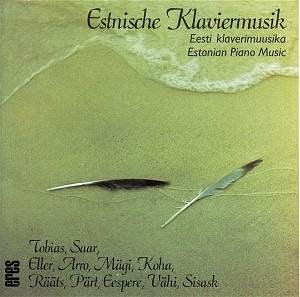Peep Lassmann's range must be wide. This disc takes us from
the proto-Beethovenian delicacy of Tobias's Menuett to the
ultima thule of Koha's aleatoric Rondo which curves
from elfin fragility to Leifs-like fury. Tiia Järg's notes
tell us of Lassmannís dedication to Messiaen's Vingt Regards and
Catalogue d'Oiseaux so we may think of him as another Sherlaw-Johnson,
Peter Hill or Roger Woodward. At the other extreme he is at home in the
'Ravel and bitters' world of Pärt's Four Dances which
lead us down fairytale paths and up peaks amid glittering rainbows and
into darker realms. This music sounds as if it was written for brave children
- an aural equivalent to the illustrations of Dulac and Kay Nielsen; not
at all the frenetic or ritualistic Pärt we might expect. Rääts'
two preludes are essentially romantic: Bridge or even early Cowell looking
out towards Reich.
Mart Saar studied composition with Rimsky and
produced some 120 pieces for solo piano. Defying its title, Skizze
is an adventurous piece for 1910 carrying portents of disaster -
a chilly Winter Waters. Eller's statuesque and gestural
The Bells stands in the littoral between Rachmaninov in his grave
Etudes-Tableaux manner and Ravel. Arro wrote many songs
and organ pieces. His Variations will appeal to those who like
their folksong dressed in nobility - Alan Bush and Percy Grainger are
parallels. Ester Mägi was a pupil of Shebalin. Usually writing
to commission, her music is woven through and through with folk material.
Her Lapland Joiks are the Estonian equivalent of Ronald Stevenson's
Celtic folk pieces for piano with suggestions of the wilderness Bartókianisms
of Erik Chisholm.
Ostinato is a feature of much Nordic music and
Eespere's Four Ostinati continue the tradition. This is
incantatory music, trance-like, sense-numbing, an intellectually robust
echo of Gurdjieff's oriental pieces. Vahi was a Tamberg pupil
and his 'symphony' relates to the Eespere work though less ostinato-rooted.
It is a grave development of the Godowsky's Borneo Suite.
Urmas Sisask's grand cycle of piano and choral
works is founded on the eighty-eight constellations. He started work
on this in 1975 and by 1993 had completed works for 29 of the constellations.
The Ram is starry-chill in Holstian apparel and gathers momentum
from a slow Bachian stroll to a shuddering onslaught. The music lacks
the cataclysmic gestures of Tubin's Second Piano Sonata but rises to
abrupt and furious defiance in the second piece, Serpentaria.
The notes are helpful and the only mildly serious criticism
is that the multi-part pieces such as those by Vahi, Sisask, Pärt,
Rääts and possibly the Arro should have had one track per
part or movement.
Deeply rewarding listening for the repertoire explorer.
Rob Barnett
